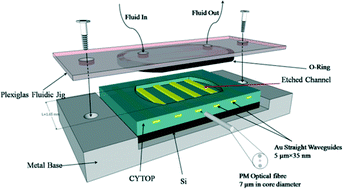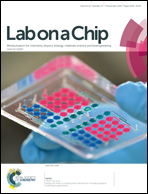Detection of leukemia markers using long-range surface plasmon waveguides functionalized with Protein G†
Abstract
A novel optical biosensor based on long-range surface plasmon-polariton (LRSPP) waveguides is demonstrated for the detection of leukemia markers in patient serum using a functionalization strategy based on Protein G. The sensor consists of thin straight Au waveguides (5 μm × 35 nm × 3.2 mm) embedded in fluoropolymer CYTOP™ with a fluidic channel etched into the top cladding. B-cell leukemia is characterized by a high B-cell count and abnormal distribution of immunoglobulin G kappa (IgGκ) and lambda (IgGλ) light chains in serum. The detection of leukemic abnormalities in serum was performed based on determining IgGκ-to-IgGλ ratios (κ : λ). Three patient sera were tested: high kappa (HKS, κ : λ ~12.7 : 1), high lambda (HLS, λ : κ ~6.9 : 1) and normal (control) sera (NS, κ : λ ~1.7 : 1). Au waveguides were functionalized with Protein G and two complementary immobilization approaches were investigated: a) the reverse approach, where the Protein G surface is functionalized with patient serum and then tested against goat anti-human IgG light chains in buffer, and b) the direct approach, where the Protein G surface is functionalized with goat anti-human IgGs first and then tested against patient serum. The reverse approach was found to be more effective and robust because Protein G-functionalized surface performs as an “immunological filter” by capturing primarily IgGs out of the pool of serum proteins. For the reverse approach, the ratios measured were 3.7 : 1(κ : λ), 9.7 : 1(λ : κ) and 1.9 : 1(κ : λ) for HKS, HLS and NS, respectively, which compare favorably with corresponding protein densitometry measurements. The respective ratios for the direct approach were 2.6 : 1(κ : λ), 2.6 : 1(λ : κ) and 1.7 : 1(κ : λ). The binding strength and cross-reactivity of goat anti-human IgGs light chains were also determined using pure solutions. The LRSPP biosensor along with the innovative “reverse approach” can provide a low-cost and compact solution to B-cell leukemia screening.


 Please wait while we load your content...
Please wait while we load your content...